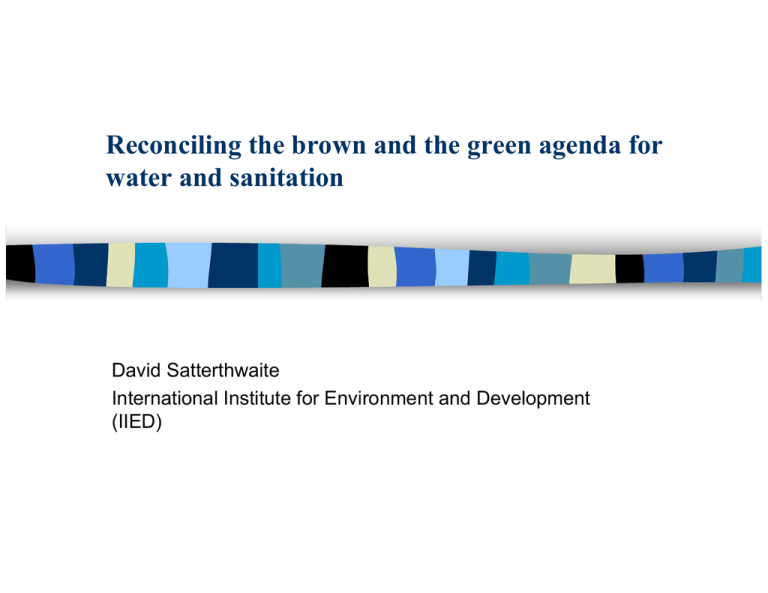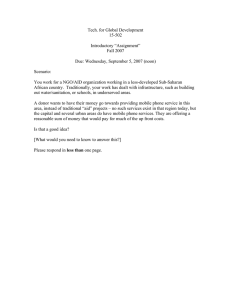Reconciling the brown and the green agenda for water
advertisement

Reconciling the brown and the green agenda for water and sanitation David Satterthwaite International Institute for Environment and Development (IIED) What this talk will cover: Reconciling the brown (environmental health) agenda & the green (ecologically sustainable) agenda in urban areas ACCOUNTABILITY: To whom are those making decisions on development investments accountable? – Governments? – Environmental pressure groups? – Those lacking provision for water and sanitation? Implementing the brown agenda in most urban areas – including improving provision for water & sanitation - is impossible without changing the relationship between local government and poorer groups 2 The origins of sustainable development From the late 1960s, clash between environmentalists & development specialists – seen in preparations for the 1972 UN Conference on the Human Environment Only One Earth – Ward and Dubos 1972 – the “charge of the U.N. to the [Stockholm] Conference was clearly to define what should be done to maintain the earth as a place suitable for human life not only now, but also for future generations” 3 Can different characteristics of the two agendas be reconciled The ‘Brown’ Environmental Health Agenda The ‘Green’ Sustainability’ Agenda First order impact Human health Ecosystem health Timing Immediate Delayed Scale Local Regional and global Worst affected Lower-income groups Future generations Priority for water Increase quantity, quality and accessibility Prevent over-use and degradation 4 Water & sanitation’s obvious advantages for brown and green agendas Directly addressing human needs Performs well in relation to future generations: – Does not make heavy use of non-renewable resources – Does not generate large volumes of hazardous nonbiodegradable wastes – Does not contribute much to greenhouse gas emissions – Based on a renewable resource (although with limits) – Does not need much fresh water in relation to total flows in most nations and locations 5 Water and sanitation In theory – Meeting human needs – Without transferring costs to other people – Without transferring costs to the future In practice, conflicts over – Support given to water & sanitation relative to other development investments – What gets prioritised in water and sanitation • how pro-poor the investments are? • How do donor structures, donor-government relationships and external pressures influence what is done/not done)? – How the costs are paid for and by whom 6 Two specific problems faced by the World Bank A bank owned by governments lending to governments – Obvious conflicts between what governments want and what is best for improving provision for poorer groups – How to serve groups that governments ignore or repress – Sewers or sewer outfalls in Mumbai? Banks need to lend to cover their own costs – A transfer of costs to future taxpayers? – Alternative criteria for success for CODI in its loans to lowincome households in regard to: • Size of loans • Number of loans • Households’ need for loans 7 Problems facing all official development agencies: Difficulties supporting processes by which most urban housing gets built – through which most lower-income groups get accommodation – 750-850 million urban squatters lacking adequate provision for water & sanitation – How to be accountable to poor groups working through governments in which poor groups have no representation (Illegal addresses; exclusion from voters’ registers) How to respond to different external groups – Northern environmental pressures more influential than demands of squatters lacking water & sanitation? 8 Commercial interests POLITICAL PROCESSES THAT OVERSEE DONOR AGENCY Non-commercial development lobbies Non-commercial environment lobby A DONOR AGENCY with its policy decisions RECIPIENT GOVERNMENT AND ITS PRIORITIES Internal structure: - has to spend or lend lots of money with relatively few staff - reliance on other agencies to implement PUBLIC OPINION AND MEDIA COMMERCIAL/POLITICAL INFLUENCES LOCAL GOVERNMENT (usually weak) LOCAL CONTRACTORS OR SERVICE PROVIDERS THE INTENDED BENEFICIARIES; THE POOR What is prioritized by most Green Agenda proponents? ‘Ecological solutions’ prioritized with no knowledge of local contexts – Yet local contexts almost always influence the most appropriate solutions Scant regard for engagement with those who lack good provision – Solutions promoted often don’t work – Criticizing solutions that work well Spurious statistics and associations in connections between inadequate provision for water/sanitation and water shortages Northern concepts applied out of context – Can encourage donor agencies to spend too much on what is not a priority (green agenda easier to implement, easier to spend large sums on, often appreciated by middle and upper income groups) 10 Commercial interests POLITICAL PROCESSES THAT OVERSEE DONOR AGENCY Non-commercial development lobbies Non-commercial environment lobby A DONOR AGENCY with its policy decisions RECIPIENT GOVERNMENT AND ITS PRIORITIES Internal structure: - has to spend or lend lots of money with relatively few staff - reliance on other agencies to implement PUBLIC OPINION AND MEDIA COMMERCIAL/POLITICAL INFLUENCES LOCAL GOVERNMENT (usually weak) LOCAL CONTRACTORS OR SERVICE PROVIDERS SUPPORT FOR Water and Sanitation THE INTENDED BENEFICIARIES; THE POOR Notes to the world’s biggest development agency from one of the smallest: The International Urban Poor Fund; Doing the brown and green agenda differently $1 million a year on which slum/shack dwellers’ organizations can draw Funding of $10,000-$80,000 available to support initiatives by savings groups formed by slum dwellers, squatters and homeless groups – who belong to larger federations In 20 nations, such federations are active 12 Examples of national federations of slum/shack dwellers/homeless people INDIA: the National Slum Dwellers Federation and Mahila Milan, supported by SPARC THAILAND: Community organizations and federations supported by CODI SOUTH AFRICA: The Federation of the Urban Poor supported by CORC ZIMBABWE AND KENYA: Urban poor federations supported by Pamoja Trust and Dialogue on Shelter Organizations and federations of the urban poor in Brazil, Cambodia, Malawi, Namibia, Nepal, the Philippines, Sri Lanka, Swaziland and Uganda, and developing in many other nations (most also supported by a local NGO) 13 2002-2006, the International Urban Poor Fund supported: Federation groups in Cambodia, Kenya, India, Malawi, Colombia, South Africa and Zimbabwe to get land for housing ‘Slum’/squatter upgrading + land tenure in Cambodia and Brazil Bridge finance for initiatives in India, Namibia and Philippines (where government support is promised but slow to come) Improved water & sanitation in Uganda, Cambodia, Sri Lanka (with improved land tenure) Slum/shack enumerations: Brazil, Namibia, Ghana, South Africa (the information base for upgrading/new house initiatives) Exchange visits by established federations to urban poor groups in East Timor, Mongolia, Angola, Tanzania, Zambia ….. Community-managed house reconstruction after the tsunami in Sri Lanka and India Federation partnerships with local governments in housing initiatives in India, Malawi, Tanzania, Zambia and Zimbabwe 14 International Urban Poor Fund 28,000 low-income people reached Not a water & sanitation programme but most initiatives included major improvements in provision – changed relationships between poor & water/sanitation agencies Dozens of precedents used to change relationship with local governments – Show what urban poor are capable of, what resources they can mobilize, how far they can make funding go External funding of $4.5 million over 5 years leveraged far more than this locally Loans used where possible so funding still being re-used World Bank allocating 0.5% of total commitments to funds such as these, directly accountable to urban poor groups? – This really would drive the brown agenda forward 15

